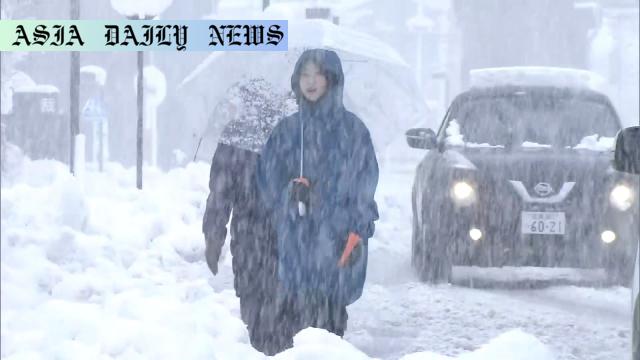Snowfall intensifies as cold air mass causes disruptions in parts of Japan. Experts foresee elevated risks through Tuesday.
- Snowfall persists in parts of Japan through Tuesday due to strong cold air mass.
- Accumulated snowfall exceeds seasonal averages in multiple regions.
- Weather officials caution against avalanches, power outages, and traffic disruptions.
- Snow depth reached over 3 meters in some areas, impacting daily life.

Winter Weather Intensifies Across Japan
Over the weekend, a strong cold air system blanketed parts of Japan in significant snowfall, particularly along the Sea of Japan coast and mountainous regions. This weather event was driven by a powerful cold air mass and a pronounced winter pressure system, creating hazardous travel conditions and disruptions in daily activities. Although the snowfall has past its peak, meteorologists predict intermittent snowfall to continue through Tuesday, especially in northern and eastern Japan.
Accumulations Far Exceed Seasonal Norms
Snowfall in the region has surpassed seasonal averages, with accumulations reaching alarming levels. During a short six-hour window on Sunday, 15 centimeters of snow blanketed Shinjo City in Yamagata Prefecture, while Minakami Town in Gunma Prefecture measured an impressive 14 centimeters. Similarly, the ski destination Nozawaonsen Village in Nagano Prefecture received a substantial 12 centimeters. In Niigata Prefecture’s Uonuma City, the town of Sumon recorded an overwhelming snow depth of 3 meters and 15 centimeters as of Sunday evening. Such unprecedented measures underscore the intensity of the current winter weather conditions.
Forecast: More Snow and High Winds
The strong cold air mass, while gradually weakening, is still expected to fuel additional snowfall. Weather projections indicate total accumulations of up to 50 centimeters in Niigata Prefecture by Monday evening, with up to 30 centimeters forecasted for regions including Hokkaido, Tohoku, Hokuriku, and northern Kanto. Alongside the snowfall, strong winds are expected to continue generating blizzard-like conditions and elevated waves off the coasts.
Government and Weather Officials Issue Urgent Warnings
Authorities are urging residents and travelers to remain vigilant against the dangers posed by these adverse conditions. Specific concerns include avalanches, power outages, and fallen trees due to the persistent weight of snow. Additionally, the possibility of high waves off the coast and icy roads warrant extreme caution. The intersection of heavy snow, strong winds, and icy conditions has already led to transportation disruptions across key regions.
Impact on Daily Life
The severe weather has particularly strained local communities where large snow accumulations are a rare challenge. Daily routines, including businesses and school operations, have been impacted. Large-scale snow removal efforts are underway, primarily in regions where road accessibility and transportation infrastructure have been greatly hindered by high snow depths.
The Role of Climate Phenomena
Weather experts have linked this intense spell of winter weather to ongoing cold waves stemming from a complex atmospheric pattern. These systems are cyclical but their increasing unpredictability may reflect broader climate changes influencing the region’s seasonal weather behaviors. Such events highlight the importance of adaptive planning in both urban and rural communities to ensure they are resilient in severe weather scenarios.
What’s Ahead?
While the cold air mass is expected to weaken over time, the immediate forecast suggests continued winter-related issues throughout northern and eastern Japan. The remaining snow, strong winds, and freezing temperatures demand concerted efforts by local organizations and the national government to mitigate impacts on infrastructure and the general population.
In conclusion, while snowfall can be a source of beauty and economic activity, the severity of this event serves as a stark reminder of nature’s duality. As the country braces for more snow, preparedness and caution are key to minimizing risks to lives and property.



Commentary
Reflecting on the Impact of Intense Snowfall
The recent heavy snowfall across Japan is a testament to the power and unpredictability of nature. While snow-covered landscapes are often associated with serenity and beauty, the reality for many regions affected by such extreme weather is far from idyllic. It is heartening to see the efforts of local governments and weather agencies in issuing precautions, but this also highlights the need for long-term planning to mitigate similar disasters in the future.
The Ripple Effects on Daily Life
The impact of these conditions extends far beyond the beautiful snow-laden vistas. For communities where snowfall is an annual occurrence, preparedness is a practiced norm; however, this event seems to have surpassed typical expectations, disrupting infrastructure, businesses, and daily routines. It’s worth considering how local governments and aid organizations could better equip regions that face such cyclical weather phenomena regularly.
The Bigger Climate Picture
One cannot discuss extreme weather without touching upon the larger subject of climate change and its potential role in intensifying such events. While cold air masses during winter seasons are expected, their intensity and frequency could hint at shifts in atmospheric systems influenced by global climate patterns. Striking a balance between immediate relief and long-term climate action would benefit not just Japan but similarly affected regions worldwide.
In closing, these heavy snowfalls are another reminder of how delicate the balance between human life and nature is. While immediate priorities lie in ensuring safety and restoring normalcy, it’s crucial to view such events as opportunities to adapt, prepare, and build resilience against future challenges.